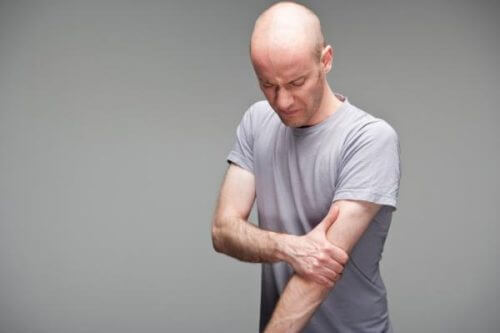The Causes of Biceps Tendinitis

Biceps tendinitis is a condition that affects the tendon of the biceps muscle. However, it doesn’t usually lead to serious consequences. It’s most often detected when a person experiences pain just by moving their arm.
Overall, many factors favor the manifestation of biceps tendinitis. These include sports activities, work activities that involve the habitual use of arm strength, and age. Although it’s rare, this problem can lead to tendon rupture if it isn’t properly treated.
Biceps tendinitis is one of the main causes of shoulder pain. Although it begins with an inflammation that causes pain, it can eventually lead to chronic injury with partial or total tendon rupture.
In this article, we’ll take a closer look at this condition and its causes.
The Biceps and its Tendons

The biceps participates in most arm movements and helps stabilize nearby joints.
Essentially, it’s the muscle that’s located in the upper arm. The distal tendon attaches the lower part of the biceps to the elbow. Then, the proximal tendons attach that muscle to the shoulder.
Basically, tendons are strong connective tissues. Here, there are two proximal tendons. These attach to the shoulder blade at various points. They help support the highest part of the arm in the shoulder socket. Similarly, they facilitate movement.
The biceps are involved in several movements. It participates forearm movement (particularly: turning the palms forward or upward). Plus, it’s also involved in elbow bending. Likewise, it helps to stabilize the shoulder joint.
What is Biceps Tendinitis?
The biceps can suffer from many injuries that can manifest in both the shoulder and its insertion in the elbow. Biceps tendonitis occurs when there’s inflammation in the long portion of the proximal tendon.
The condition causes severe pain in the anterior shoulder. Generally, this occurs when a person’s arm is raised above the shoulder. However, this condition makes it difficult to do everyday activities, such as putting on a shirt, throwing a ball, sleeping on the affected area, etc.
Read: How to Relieve Tendinitis with Very Effective Natural Solutions
Causes of this Condition

Sports, work activities that involve the habitual use of arm strength, and age affect the biceps.
The most common cause of biceps tendonitis is overuse, either due to sports or work activities or another condition. Similarly, the most common are inflammatory diseases, rotator cuff injuries, impairments of previous injuries, trauma, or subacromial impingement syndrome.
Sometimes, the humeral head is abnormally raised and moved forward, which can damage the biceps. This leads to a condition known as subacromial impingement syndrome, which can also lead to biceps tendinitis.
All of the above causes inflammation, edema, or small tears. If the problem progresses, chronic degeneration can occur. This leads to the alteration of the normal collagen fibers of the tendon. Eventually, it could lead to partial or complete tendon rupture.
This article may interest you: How to Improve the Symptoms of Tendonitis
Prevention of Biceps Tendinitis
The main way to prevent this condition is by avoiding all activities that involve placing your arms above your head too often. These movements are very common in sports such as baseball and tennis.
If you can’t avoid making these movements, you should do exercises to strengthen the muscles of your shoulder and upper arm. If your shoulder muscles are well developed, the arm won’t lose stability and therefore will be less prone to injury.
Another preventive measure is to do these movements with a proper technique. Strange or awkward postures subject the shoulder to excessive stress, which ends up triggering problems such as biceps tendinitis.
If you feel pain while doing a particular activity, stop doing it until you get checked out by a doctor.
All cited sources were thoroughly reviewed by our team to ensure their quality, reliability, currency, and validity. The bibliography of this article was considered reliable and of academic or scientific accuracy.
Bard, H. (2012). Tendinopatías: etiopatogenia, diagnóstico y tratamiento. EMC-Aparato locomotor, 45(3), 1-20.
This text is provided for informational purposes only and does not replace consultation with a professional. If in doubt, consult your specialist.








